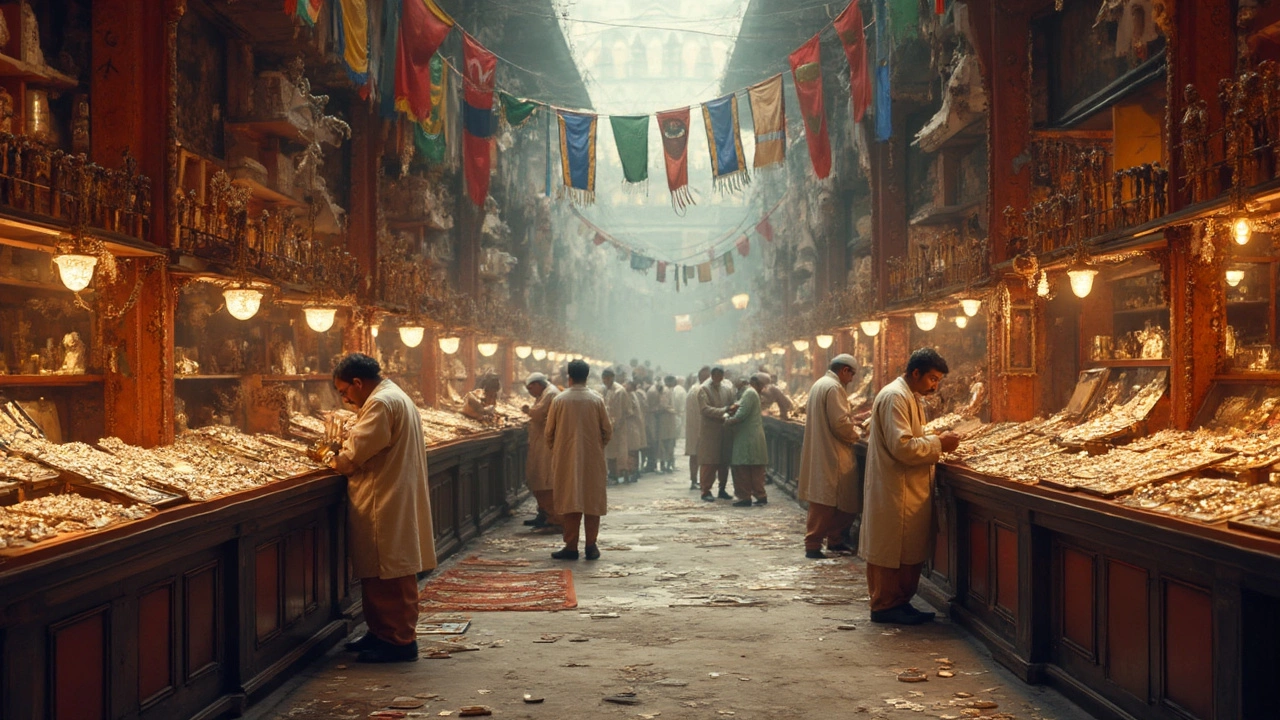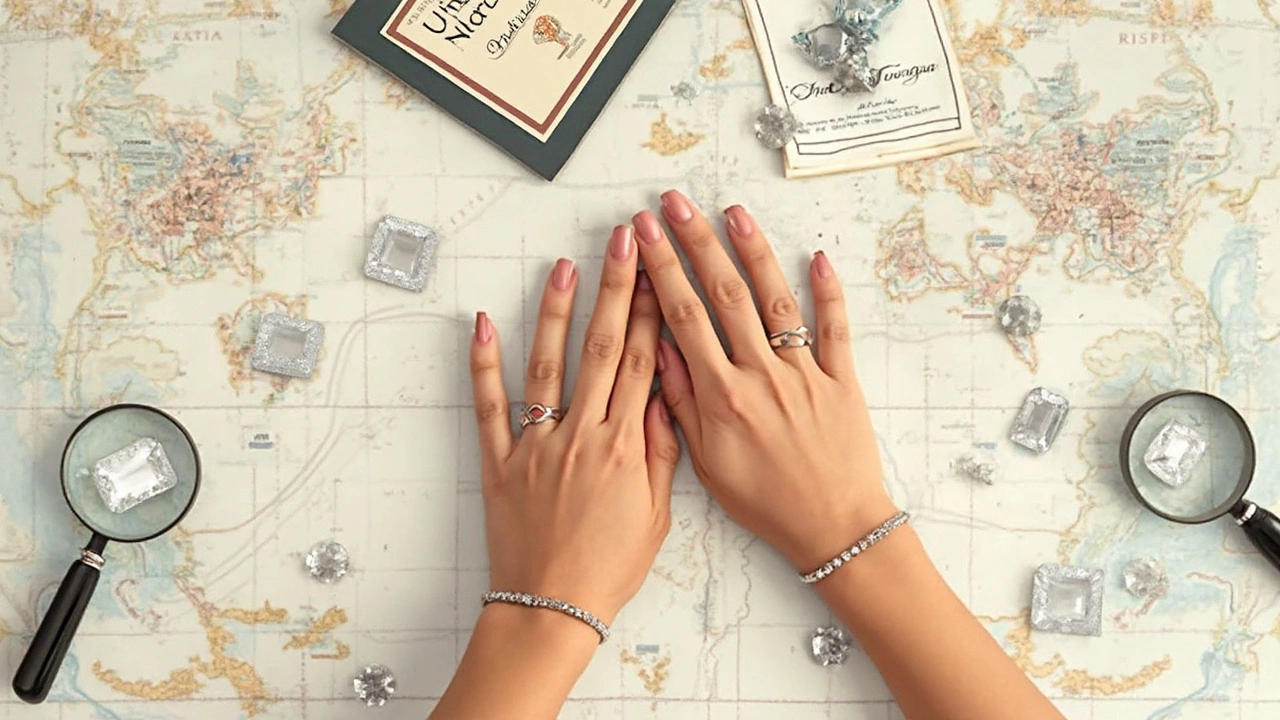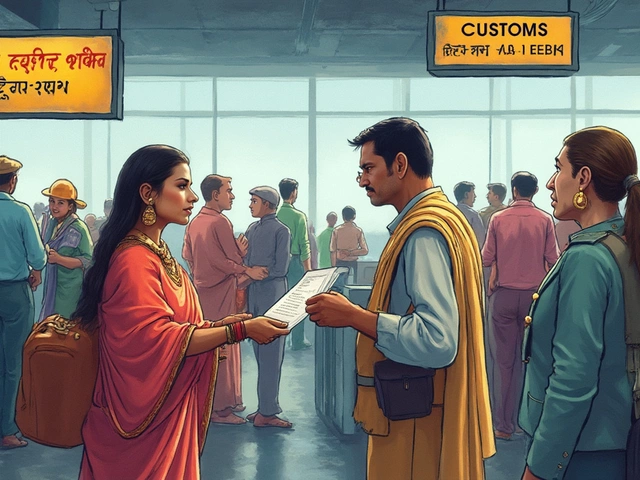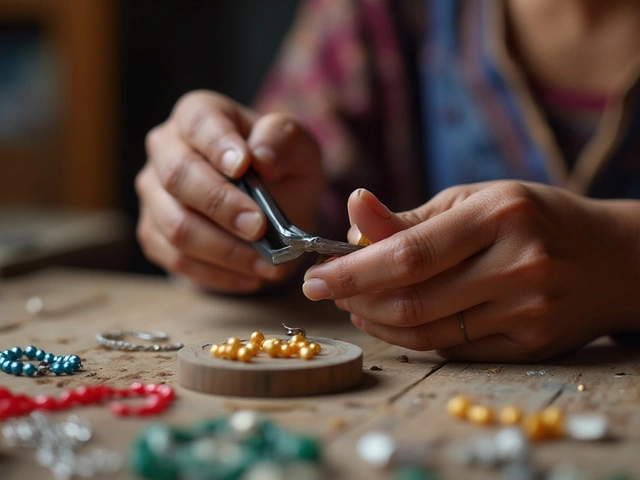
Diamond shopping isn't just about picking something that sparkles—it's also about where you buy it. A diamond can cost a fortune in one country, and be much more affordable just across a border. You might be surprised to learn that the difference isn’t always because one diamond is better than the other.
If you’re planning to buy a diamond ring or just want a good deal on a loose stone, looking beyond your local market can save you serious cash. But why do diamond prices jump around so much from country to country? It comes down to taxes, how close a country is to the source, production costs, and even how popular diamonds are locally. That means a shopper in Mumbai might get a totally different price than someone in New York—even for the same grade of diamond.
Before you start booking flights or browsing online stores from halfway around the world, it helps to know where the best deals are and what hidden costs might hit you after the fact. Understanding how the diamond market actually works could save you thousands and spare you from classic mistakes buyers make when chasing a bargain.
- Why Diamond Prices Differ by Country
- The Top Countries for Cheap Diamonds
- How Taxes and Duties Affect Diamond Costs
- India’s Diamond Market: What Sets It Apart?
- Tips for Buying Diamonds Abroad
- Final Thoughts: Getting the Best Deal
Why Diamond Prices Differ by Country
If you’ve ever compared diamond prices in different countries, you’ll notice there’s no single global price tag. There are a few real reasons why a diamond price in India might be cheaper than one in the US, and it’s not just about the cost to mine or cut it. The whole diamond pipeline, from the mine to your finger, shapes what you pay.
First, government taxes and import duties play a huge role. Some countries charge hefty tariffs on importing diamonds, while others either reduce or skip them for gems. For example, India, a hotspot for diamond rings india, has historically offered tax breaks to its local jewelry industry, helping keep retail prices lower. The US, in comparison, slaps on notable import duties, making each stone pricier for American buyers.
Next is supply and demand. Countries with big diamond cutting and trading hubs, like India and Belgium, see tons of stones move through their markets each day. This cuts down on markups as dealers compete to sell fast, pushing prices down.
Here’s another factor—labor and production costs. Skilled diamond cutters in India get paid much less than those in Europe or the US, driving down the cheapest diamonds you’ll find there. It makes sense: cheaper labor usually trickles down to cheaper stones for buyers.
Currency value swings can shake up the final price too. If the local currency drops against the dollar, diamond prices (set globally in dollars) may suddenly get more attractive in the cheaper country.
Let’s break down just a few of these differences:
| Country | Import Tax/Duty (%) | Major Cutting Center |
|---|---|---|
| India | 0-5 (varies by state and form) | Yes |
| USA | Up to 6.5 | No |
| Belgium | 0 | Yes |
| China | 8.4 | Yes |
Finally, local buying trends and what’s popular matter too. In countries where diamonds aren’t as trendy, you can score a bargain. In places obsessed with bling, well, expect to pay more. That’s why it pays to look at how these nuts-and-bolts details shape the real diamond prices you see in stores.
The Top Countries for Cheap Diamonds
When people think about cheapest diamonds, most assume South Africa tops the list since that's where a lot of diamonds come from. But the real story is a bit more interesting. In reality, the countries where you’ll find the best diamond deals are India, Belgium, the UAE (specifically Dubai), and to some extent, Israel.
India is a star player here. Surat, a city in Gujarat, isn’t just a dot on the map—over 90% of the world’s diamonds are cut and polished there. That means a lot of savings get passed on to buyers, especially locals. Since there’s no need to pay extra for international shipping, tariffs, or middlemen, diamond rings India usually come with much better price tags compared to the west. Here’s a fact for you: The average retail markup on diamonds in India can be as low as 10–15%, while the same stones get marked up 30–50% in the US or Europe.
Then there’s Belgium, with Antwerp being nicknamed the “diamond capital of the world.” Antwerp’s massive exchange is responsible for around half of all rough diamonds that hit the global market. If you know how to bargain and understand grading, you can find some of the world’s finest (and fairly-priced) stones here. But keep in mind, VAT (Value Added Tax) can push prices up if you’re not familiar with expat or tourist rebate processes.
Now let’s talk about Dubai. The United Arab Emirates attracts serious buyers because of its tax-free diamond trading policies. No import taxes and low or zero retail taxes mean the savings can be passed directly to customers. If you’re hoping for luxury on a budget, it’s hard to beat.
Israel is another biggie. Their diamond exchange deals mostly with high-quality stones, but thanks to competitive trading and advanced technology, you might still spot some good deals as long as you watch out for steep service fees.
| Country | Main Selling Point | Typical Markup (%) | Taxes/Duties |
|---|---|---|---|
| India | World's largest diamond-cutting industry, low markup | 10-15 | Low |
| Belgium | Wholesale hub, huge selection | 15-20 | High VAT |
| UAE (Dubai) | Tax-free shopping, global hub | 10-12 | None |
| Israel | Focus on high-quality stones | 12-18 | Moderate taxes |
Just remember, cheap isn’t always best—certification, grading, and trust still matter. As industry expert Russell Shor famously said,
“A good price on a diamond only counts if the grading and authenticity are bulletproof. Always buy with your eyes open and paperwork in hand.”
So, next time you’re hunting for diamond prices that won’t destroy your savings, start with these countries—but double-check what you’re actually getting before you buy.
How Taxes and Duties Affect Diamond Costs
When it comes to diamond prices, taxes and import duties can really mess with your budget. Just because a country has cheap diamonds at source doesn’t mean you’ll actually pay less once you check out—governments love to add their slice to the cost.
Let’s keep it simple—every time a diamond crosses a border, someone’s taxing it. Most countries add import duties, value-added tax (VAT), or goods and services tax (GST). For instance, if you buy a diamond ring in India and take it back to the US, customs could hit you with a duty of up to 6.5%. Over in Europe, VAT can add another 20% or more to the final bill. Sometimes, these extra costs are included in the sticker price, but often they sneak up on you right at the end.
| Country | Import Duty (%) | VAT/GST (%) |
|---|---|---|
| India | 0 (on loose stones) | ~3% |
| USA | 0 (loose, not set) | Varies by state |
| UK | 0 (on loose stones) | 20% |
| China | 9% | 13% |
Sometimes, the rules are more complicated. In India, buying a diamond ring has about 3% GST tacked on, but loose diamonds may be taxed less. In the US, the price you see isn’t always what you pay—sales tax will hit you at checkout, and that can be anywhere from 0% to 10% depending on your state.
- Always ask your seller if the price includes taxes and duties, especially if you’re buying online.
- Check your home country’s customs rules. Sneaking a ring in your luggage could get you fined if you’re stopped at the border.
- If you’re shopping as a tourist in a country, you might score a VAT refund, like in the UK or EU, but you’ll need to follow the paperwork trail exactly.
So, even if India or another country looks the cheapest for diamond rings up front, always factor in taxes and hidden fees. Otherwise, that bargain can quickly turn into a wallet-drainer.

India’s Diamond Market: What Sets It Apart?
When people ask, "Where is the cheapest diamond found?" India almost always comes up. It’s not just a fluke—there are a few solid reasons why you’ll hear this over and over, especially if you’ve ever shopped for diamond rings in India.
First off, India handles about 90% of the world’s diamond cutting and polishing. We’re talking about Surat, a city that pretty much runs the global diamond scene when it comes to transforming rough stones into dazzling gems. Since so many diamonds pass through Indian hands, there’s less shipping and middleman markup if you buy locally.
On top of that, labor costs in India are much lower than in places like Europe or the U.S. That means the price you pay for a finished gem usually skips the premium charged for the same stone after it travels halfway around the globe. Plus, if you’re in the market for lower-carat or small stones, India is THE place—most of those are cut and set right there.
"India’s diamond industry offers unbeatable value, especially for smaller stones. Savings can reach 20-30% compared to Western markets," says Gemological Institute of America insider Rahul Mehta.
One thing most folks forget—India also has a massive local demand for diamonds. Whether it’s for engagement rings or traditional jewelry, there’s always a market, so you get heaps of options and competitive prices. If you pop into any big city market—think Mumbai’s Zaveri Bazaar or Surat’s Mahidharpura—you’ll see dozens of shops lined up, all hustling to offer you a deal.
To give you an idea where diamonds are coming from and going to out of India, here’s a stat from the Gem & Jewellery Export Promotion Council:
| Year | Diamonds Processed (Million Carats) | Exports Value (Billion USD) |
|---|---|---|
| 2022 | 130 | 24.7 |
| 2023 | 126 | 23.5 |
Quick heads-up if you’re buying for export—India’s got low import duties for rough diamonds and favorable tax policies for traders, which is another reason the diamond prices here beat most other places. But always double check if you’re taking stones home; you could be hit by taxes or import limits in your country.
So, if you’re thinking of a diamond hunt in India, you’ve picked the right spot. Just make sure you get proper certification from a recognized lab so you’re not trading price for peace of mind. With the right approach, you can walk away with the real deal and save a chunk compared to what you’d pay elsewhere.
Tips for Buying Diamonds Abroad
So you’re thinking about buying a diamond overseas. Good move—if you know what you’re doing. Getting a bargain on diamond prices in another country sounds awesome, but it’s easy to get tripped up if you don’t pay attention to the details.
Here’s what you need to consider before dropping cash on that shiny rock:
- Know the 4Cs Everywhere: Cut, color, clarity, and carat weight matter no matter where you are. Don’t get distracted by flashy settings if the actual stone doesn’t check out. Always check the diamond rings india market standards—Indians, for example, are particular about clarity (VS or better is the norm).
- Always Get a Lab Certificate: If a dealer isn’t offering a certificate from GIA, IGI, or HRD, walk away. Local certifications might not mean much once you’re home. A legit certificate is a must if you want to compare diamond prices anywhere, or be able to resell later.
- Ask About Import Duties & Taxes: Sure, that cheapest diamonds tag looks sweet, but once you fly home, customs might hit you with surprise fees. For example, bringing a diamond ring into India is subject to a 12.5% import duty, plus GST on top. That can eat up any savings you scored abroad.
- Shop in Trusted Markets: Cities like Antwerp, Mumbai, and Dubai are known for bulk trading and sharp prices, thanks to the sheer volume of deals done there. But not everyone in the bazaar is legit—always buy from a certified retailer.
- Do a Currency Conversion Reality Check: Sometimes a diamond seems cheaper simply because of exchange rate differences. Don’t forget to factor in conversion costs and possible fluctuations if you’re paying with a card.
- Check Local Consumer Protection Laws: Know what happens if you need to return, exchange, or dispute a diamond purchase. Some countries make it simple. Others, not so much.
If you want a quick look at how costs can stack up, here’s an example of what paying import duties between three popular countries could look like for a $5,000 diamond:
| Country | Import Duty | VAT/GST | Total Possible Fees |
|---|---|---|---|
| India | 12.5% | 3% | $775 |
| USA | 0% | Varies by state | $0–$400+ |
| UK | 2.5% | 20% | $1,125 |
Bottom line: do your homework before you buy. Ask direct questions. Compare more than just sticker prices. If anything feels shady, trust your gut—and keep your wallet closed.
Final Thoughts: Getting the Best Deal
Finding the cheapest diamonds isn’t just about location; it’s also about timing and being a smart buyer. Buying directly in India, for example, often means lower prices because you're closer to where the diamonds are cut and sold. Indian cities like Surat handle over 90% of the world’s cut and polished diamonds, which drives prices down compared to Western markets. But there’s more to the story than just the price tag.
If you’re serious about scoring a deal, make sure you:
- Compare prices online—even if you’re shopping in person. Sites like Rapaport Price List give you a ballpark figure of what’s reasonable, especially for diamond rings India buyers.
- Check for certification. Always ask for a grading report from GIA or IGI. This gives you proof of what you’re buying, no matter which country you’re in.
- Add up the taxes and duties. Some countries, like Thailand and the UAE, offer duty-free diamond buying. But if you bring the stone back home, customs might hit you with extra charges.
- Negotiate, especially in places like India or Dubai. In these markets, sellers expect you to ask for a better price—it’s all part of the process.
Want some hard numbers? Here’s a quick look at what you might expect to pay for a 1-carat, VS2 clarity, H color stone in 2025:
| Country | Average Price (USD) |
|---|---|
| India | 3,400 |
| UAE (Dubai) | 3,700 |
| USA | 4,400 |
| Europe | 4,900 |
As you can see, India is usually the winner for diamond prices, especially if you're looking for variety and want to customize your stone at the source. But, cheaper isn’t always better if you end up with a badly cut diamond or get hit by big taxes at home.
"The best diamond deal isn't always the lowest price—it’s the best balance of quality, service, and transparency." — Gemological Institute of America (GIA)
So, if you want the best deal, keep your eyes peeled for hidden costs and never skip on certification. You’ll walk away with a stone that’s worth every penny, whether you buy your diamond in Mumbai, Dubai, or back home.


